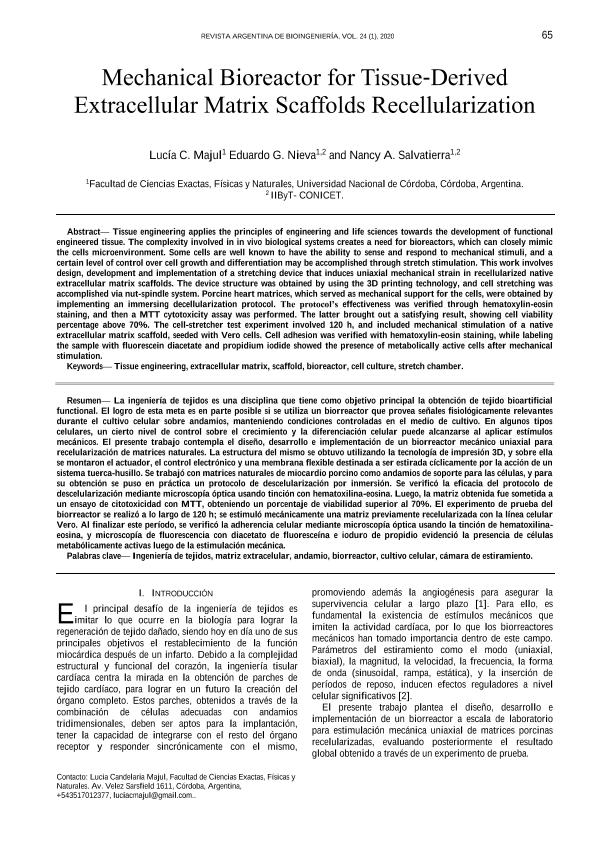Artículo
Tissue engineering applies the principles of engineering and life sciences towards the development of functional engineered tissue. The complexity involved in in vivo biological systems creates a need for bioreactors, which can closely mimic the cells microenvironment. Some cells are well known to have the ability to sense and respond to mechanical stimuli, and a certain level of control over cell growth and differentiation may be accomplished through stretch stimulation. This work involves design, development and implementation of a stretching device that induces uniaxial mechanical strain in recellularized native extracellular matrix scaffolds. The device structure was obtained by using the 3D printing technology, and cell stretching was accomplished via nut-spindle system. Porcine heart matrices, which served as mechanical support for the cells, were obtained by implementing an immersing decellularization protocol. The protocol’s effectiveness was verified through hematoxylin-eosin staining, and then a MTT cytotoxicity assay was performed. The latter brought out a satisfying result, showing cell viability percentage above 70%. The cell-stretcher test experiment involved 120 h, and included mechanical stimulation of a native extracellular matrix scaffold, seeded with Vero cells. Cell adhesion was verified with hematoxylin-eosin staining, while labeling the sample with fluorescein diacetate and propidium iodide showed the presence of metabolically active cells after mechanical stimulation. La ingeniería de tejidos es una disciplina que tiene como objetivo principal la obtención de tejido bioartificial functional. El logro de esta meta es en parte posible si se utiliza un biorreactor que provea señales fisiológicamente relevantes durante el cultivo celular sobre andamios, manteniendo condiciones controladas en el medio de cultivo. En algunos tipos celulares, un cierto nivel de control sobre el crecimiento y la diferenciación celular puede alcanzarse al aplicar estímulos mecánicos. El presente trabajo contempla el diseño, desarrollo e implementación de un biorreactor mecánico uniaxial para recelularización de matrices naturales. La estructura del mismo se obtuvo utilizando la tecnología de impresión 3D, y sobre ella se montaron el actuador, el control electrónico y una membrana flexible destinada a ser estirada cíclicamente por la acción de un sistema tuerca-husillo. Se trabajó con matrices naturales de miocardio porcino como andamios de soporte para las células, y para su obtención se puso en práctica un protocolo de descelularización por inmersión. Se verificó la eficacia del protocolo de descelularización mediante microscopía óptica usando tinción con hematoxilina-eosina. Luego, la matriz obtenida fue sometida a un ensayo de citotoxicidad con MTT, obteniendo un porcentaje de viabilidad superior al 70%. El experimento de prueba del biorreactor se realizó a lo largo de 120 h; se estimuló mecánicamente una matriz previamente recelularizada con la línea celular Vero. Al finalizar este período, se verificó la adherencia celular mediante microscopía óptica usando la tinción de hematoxilinaeosina, y microscopía de fluorescencia con diacetato de fluoresceína e ioduro de propidio evidenció la presencia de células metabólicamente activas luego de la estimulación mecánica.
Mechanical bioreactor for tissue-derived extracellular matrix scaffolds recellularization
Fecha de publicación:
04/2020
Editorial:
Sociedad Argentina de Bioingeniería
Revista:
Revista Argentina de Bioingeniería
ISSN:
2591-376X
Idioma:
Inglés
Tipo de recurso:
Artículo publicado
Clasificación temática:
Resumen
Archivos asociados
Licencia
Identificadores
Colecciones
Articulos(IIBYT)
Articulos de INSTITUTO DE INVESTIGACIONES BIOLOGICAS Y TECNOLOGICAS
Articulos de INSTITUTO DE INVESTIGACIONES BIOLOGICAS Y TECNOLOGICAS
Citación
Majul, Lucia; Nieva, Eduardo Gabriel; Salvatierra, Nancy Alicia; Mechanical bioreactor for tissue-derived extracellular matrix scaffolds recellularization; Sociedad Argentina de Bioingeniería; Revista Argentina de Bioingeniería; 24; 1; 4-2020; 65-71
Compartir




